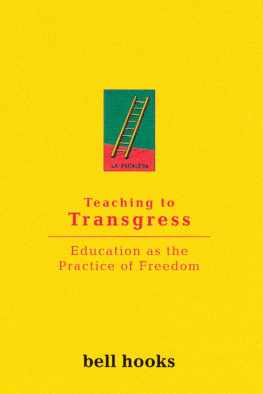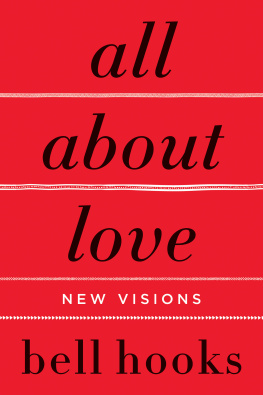Reel to Real
hooks makes a compelling case to filmmakers for creating progressive images that 'transform the culture we live in'.
Los Angeles Times
bell
hooks
Reel to Real
Race, class and sex at the movies

First published 1996
by Routledge
First published in Routledge Classics 2009
by Routledge
711 Third Ave, New York, NY 10017
Simultaneously published in the UK
by Routledge
2 Park Square, Milton Park, Abingdon, Oxon 0X14 4RN
Routledge is an imprint of the Taylor & Francis Croup,
an informa business
1996, 2009 bell hooks
Typeset in Joanna by RefineCatch Limited, Bungay, Suffolk
All rights reserved.
No part of this book may be reprinted or reproduced or utilized in any form or by any electronic, mechanical, or other means, now known or hereafter invented, including photocopying and recording, or in any information storage or retrieval system, without permission in writing from the publishers.
LIBRARY OF CONGRESS CATALOGING IN PUBLICATION DATA
A catalog record for this book has been requested
BRITISH LIBRARY CATALOGUING IN PUBLICATION DATA
A catalogue record for this book is available from the British Library
ISBN10: 0-415-96480-6
ISBN13: 978-0-415-96480-7
for the filmmaker who still dreams
We used to dream the same dreams. That was how I knew you would love me in the end.
Contents
Introduction: Making Movie Magic
Good Girls Look the Other Way
Transgression and Transformation: Leaving Las Vegas
Exotica: Breaking Down to Break Through
Crooklyn: The Denial of Death
Cool Cynicism: Pulp Fiction
Mock Feminism: Waiting to Exhale
Kids: Transgressive Subject MatterReactionary Film
Artistic Integrity: Race and Accountability
Neo-Colonial Fantasies of Conquest: Hoop Dreams
Doing it for Daddy: Black Masculinity in the Mainstream
Thinking Through Class: Paying Attention to The Attendant
Back to the Avant-Garde: The Progressive Vision
Whats Passion Got to Do With It? An Interview with Marie-France Alderman
The Cultural Mix: An Interview with Wayne Wang
ConfessionFilming Family: An Interview with Artist and Filmmaker Camille Billops
A Guiding Light: An Interview with Charles Burnett
Critical Contestations: A Conversation with A. J. (Arthur Jaffa)
The Oppositional Gaze: Black Female Spectators
Is Paris Burning?
Whose Pussy Is This? A Feminist Comment
1
INTRODUCTION: MAKING MOVIE MAGIC
Movies make magic. They change things. They take the real and make it into something else right before our very eyes. Usually when I critique a movie lots of folks like, they tell me, It was just showing the way things are. It was real. And they do not want to hear it when I make the point that giving audiences what is real is precisely what movies do not do. They give the reimagined, reinvented version of the real. It may look like something familiar, but in actuality it is a different universe from the world of the real. Thats what makes movies so compelling. Talking about the need for an aesthetic ecology wherein the artistry of films is not submerged by any other agenda, visionary filmmaker Stan Brakhage shares this insight: All this slavish mirroring of the human condition feels like a bird singing in front of mirrors. The less a work of art reflects the world the more is being in the world and having its natural being like anything else. Film must be free from all imitations, of which the most dangerous is the imitation of life.
Most of us go to movies to enter a world that is different from the one we know and are most comfortable with. And even though most folks will say that they go to movies to be entertained, if the truth be told lots of us, myself included, go to movies to learn stuff. Often what we learn is life-transforming in some way. I have never heard anyone say that they chose to go to a movie hoping it would change them utterlythat they would leave the theater and their lives would never be the sameand yet there are individuals who testify that after seeing a particular film they were not the same. Much of what Jeanette Winterson attributes to the power of the literary texts in her collection Art Objects: Essays on Ecstasy and Effrontery is equally true of cinematic narratives. She contends: Strong texts work along the borders of our minds and alter what already exists. They could not do this if they merely reflected what already exists. As cultural critics proclaim this postmodern era the age of nomadism, the time when fixed identities and boundaries lose their meaning and everything is in flux, when border crossing is the order of the day, the real truth is that most people find it very difficult to journey away from familiar and fixed boundaries, particularly class locations. In this age of mixing and hybridity, popular culture, particularly the world of movies, constitutes a new frontier providing a sense of movement, of pulling away from the familiar and journeying into and beyond the world of the other. This is especially true for those folks who really do not have much money or a lot of time as well as for the rest of us. Movies remain the perfect vehicle for the introduction of certain ritual rites of passage that come to stand for the quintessential experience of border crossing for everyone who wants to take a look at difference and the different without having to experientially engage the other.
Whether we like it or not, cinema assumes a pedagogical role in the lives of many people. It may not be the intent of a filmmaker to teach audiences anything, but that does not mean that lessons are not learned. It has only been in the last ten years or so that I began to realize that my students learned more about race, sex, and class from movies than from all the theoretical literature I was urging them to read. Movies not only provide a narrative for specific discourses of race, sex, and class, they provide a shared experience, a common starting point from which diverse audiences can dialogue about these charged issues. Trying to teach complicated feminist theory to students who were hostile to the reading often led me to begin such discussions by talking about a particular film. Suddenly students would be engaged in an animated discussion deploying the very theoretical concepts that they had previously claimed they just did not understand.
It was this use of movies as a pedagogical tool that led me to begin writing about films as a cultural critic and feminist theorist. Centrally concerned with the way movies created popular public discourses of race, sex, and class, I wanted to talk about what these discourses were saying and to whom. Particularly, I wanted to interrogate specific films that were marketed and critically acclaimed as progressive texts of race, sex, and class to see if the messages embedded in these works really were encouraging and promoting a counterhegemonic narrative challenging the conventional structures of domination that uphold and maintain white supremacist capitalist patriarchy. Even though many traditional academic film critics are convinced that popular art can never be subversive and revolutionary, the introduction of contemporary discourses of race, sex, and class into films has created a space for critical intervention in mainstream cinema. Often multiple standpoints are expressed in an existing film. A film may have incredibly revolutionary standpoints merged with conservative ones. This mingling of standpoints is often what makes it hard for audiences to critically read the overall filmic narrative. While audiences are clearly not passive and are able to pick and choose, it is simultaneously true that there are certain received messages that are rarely mediated by the will of the audience. Concurrently, if an individual watches a film with a profoundly politically reactionary message but is somehow able to impose on the visual narrative an interpretation that is progressive, this act of mediation does not change the terms of the film.
Next page















